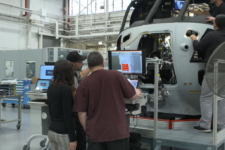
F-35 production line (File)
At this point, you would be hard pressed to find someone in the DC defense establishment who doesn’t think the acquisition system needs reforms, with a focus on bringing new commercial technology to the battlefield. But as Stephanie Halcrow argues in this op-ed, there are some simple steps that the Pentagon could take right now to start the process and increase the health of the defense industrial base.
In 2018, the Defense Department submitted a unique report on the defense industrial base in response to Executive Order 13806. The findings were not encouraging: the review warned macro forces at work across the industrial base were producing a “deterioration in US capabilities,” and that there was “a surprising level of foreign dependence on competitor nations.”
The DoD’s subsequent Industrial Capabilities reports to Congress in 2019 and 2020 were equally pessimistic, and the defense industrial base agrees with that assessment; the National Defense Industrial Association gave the defense industrial base a “C” rating in both the Vital Signs 2020 and Vital Signs 2021 annual assessments.
There are steps the DoD can and must take now to start addressing these challenges.
The department can start by better leveraging and expanding the commercial defense industrial base. But to attract new commercial entrants, the Department of Defense needs to embrace commercial practices, not try to impose DoD practices on commercial companies. Specifically, DoD must scale market research to leverage commercial products and services, get serious about removing and streamlining regulations, and take a little more risk.
There are several market research organizations in DoD, such as the Defense Innovation Unit which are focused on fielding and scaling commercial technology for the US military. The department should build on organizations like DIU and use its geographic presence across the United States to scale its engagement with commercial industry. Most importantly, DoD’s market research effort should be driven by its national security strategy for the defense industrial base and be laser-focused on eliminating the gaps and vulnerabilities identified in its continuous monitoring of the supply chain.
In addition to scaling market research, the department needs to remove the complexity, restrictions, and scrutiny of its procurement and contract management processes to attract new commercial entrants. Some would advocate for finding workarounds to the current process, but a sustainable long-term solution is to streamline the current process to be less burdensome.
To its credit, the Pentagon has taken some recent steps to address burdensome regulations. NDIA’s Vital Signs 2021 rightly commended DoD for reducing the regulatory burdens in the Federal Acquisition Regulation (FAR) and Defense Federal Acquisition Regulation Supplement (DFARS). In fact, NDIA reported the “red tape” burden score decreased each of the last three years.
However, more needs to be done. There are still more opportunities to remove outdated regulations, and administration and department leaders should work together to undertake a focused, long-term effort on first streamlining, and then reducing, regulations in the FAR and DFARS.
Here’s a simple example: the FAR includes a clause encouraging contractors to develop policies to ban text messaging while driving. While a reasonable goal, should this really be a FAR clause? It might make the roads safer, but it’s not exactly national security focused.
Embarking on a reform effort like this is challenging and time consuming, much more so than skirting the current process. But the dividends are far greater and longer lasting than using workarounds. Streamlining and reducing regulations will save taxpayer dollars, speed up the acquisition process, make the Pentagon more appealing to commercial industry, and, ultimately, improve supply chain security.
While this effort is underway, the DoD should prioritize the use of commercial procurement procedures, including using standard terms and conditions as an easy way to remove the regulatory barriers and solidify the commercial industry partnership.
Finally, DoD needs to be comfortable with taking more risk and moving past awarding only pilot and prototype contracts to commercial industry. This is not the path to improve the health and resiliency of the defense industrial base or enhance supply chain security. Instead, DoD must award procurement contracts to new commercial entrants to bring the best of America’s manufacturing to solve national security problems.
There is comfort with doing business as usual, but comfort and business as usual is a sure path to getting left behind. It is time to stop admiring the problems with our defense industrial base and do business differently.
Stephanie Halcrow is a former Professional Staff Member on the House Armed Services Committee where she covered acquisition and industrial base policy. She also served as staff in the United States Senate and is a retired United States Air Force officer.
Sullivan: Defense industry ‘still underestimating’ global need for munitions
National Security Advisor Jake Sullivan said that there are “no plans” for another Ukraine supplemental at this point.


























